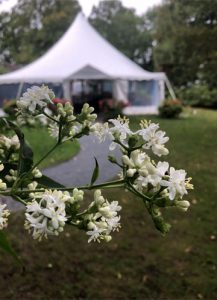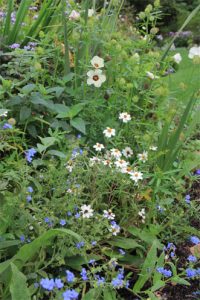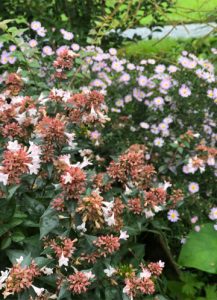Along the Garden Path

September’s Charm

Seven-son-flower (Heptacodium miconiodes) by the wedding tent
Each week of September has its own charm. Towards the end of September, a garden walk reveals many floral discoveries for shrubs, perennials and annuals. They all mix together exuberantly for a late-season show. This is the time to see which plants have had the staying power to perform through this year’s extreme weather.
By the wedding tent the large shrub, seven-son flower (Heptacodium miconiodes), is just blooming with fragrant white flowers. Both honeybees and bumblebees are happy to feed on it. Another September stalwart is the autumn crocus (Colchicum autumnale), blooming each year on the edge of the bosquet. Their foliage emerges in April and May looking like large daffodil foliage; it then dies back to the ground completely; months later the flowers bloom without any foliage (whence the name “naked ladies”).

Blue Chinese-forget-me-not (Cynoglossum amabile), Mexican zinnia (Zinnia angustifolia) and the flower-an-hour (Hibiscus trionum)

Glossy Abelia (Abelia x grandifolia), New England aster
(Symphyotrichum novae angliae)
The North Garden could win the longevity award for a colorful mix of flowers starting in mid-April and continuing into October. To the observant eye, is a sweet little combination of annuals: blue Chinese -forget-me -not (Cynoglossum amabile), white Mexican zinnia (Zinnia angustifolia) and the flower-an- hour (Hibiscus trionum); these three have been happily blooming together since July. In the back of the North Garden border, the shrub glossy abelia (Abelia x grandifolia) has been blooming from early August with pinkish flowers and is now joined by New England asters (Symphyotrichum novae angliae) in lavender colors. Long-blooming flowers help keep this garden colorful through the seasons.
Further along the path, the Idea Garden has the most impact of color. Cardinal climber (Ipomoea x multifida) growing on the bamboo arches are in their full glory. Hummingbirds feast on the flowers most of the day: they are stoking themselves up for their imminent southern migration, usually around the first week in October. We will miss their charm and energy in the garden.
Come and see them soon!
Featured Image: Autumn crocus (Colchicum autumnale) blooming in the Bosquet
Click here to see Gail’s video of a hummingbird on a Cardinal Climber.
